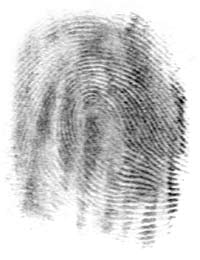Fingerprint
|
|
- This article is about human fingerprints. For "digital fingerprints," see message digest. For "DNA fingerprints" see Genetic fingerprinting.
A fingerprint is an imprint made by the pattern of ridges on the pad of a human finger. Fingerprints are commonly believed to provide traction for grasping objects. These prints are often left on objects at a crime scene and are therefore used in forensic science to identify suspects. No two humans have ever been found to have identical fingerprints, thus fingerprints are widely believed to be unique.
Fingerprints are an early example of biometrics, the science of identifying individuals by their physical characteristics. There is no clear date at which fingerprinting was first used, some examples being from prehistory. However, some significant modern dates are as follows.
- 1880 - Dr. Henry Faulds published his first paper on the subject in the scientific journal Nature in 1880. Returning to Britain in 1886, he offered the concept to the Metropolitan Police in London but was dismissed.
- 1892 - Sir Francis Galton published a detailed statistical model of fingerprint analysis and identification and encouraged its use in forensic science in his book Finger Prints.
- 1901 - Sir Edward Richard Henry devised the Henry Classification System used in England and Wales.
- 1902 - Dr. Henry P. DeForrest used fingerprinting in the New York Civil Service.
Sometimes the prints are invisible, in which case they are called latent fingerprints, but there are chemical techniques such as cyanoacrylate fuming and ninhydrin spray that can make them visible.
Recently the American Federal Bureau of Investigation adopted the D9/7 wavelet-based system for efficient storage of fingerprint data, developed by Ingrid Daubechies. The FBI manages a fingerprint database called IAFIS, which currently holds the fingerprints of over forty-seven million subjects.
In the 2000s, electronic fingerprint readers have been introduced for security applications such as identification of computer users (log-in authentication). However, early devices have been discovered to be vulnerable to quite simple methods of deception, such as fake fingerprints cast in gels.
There is some controversy over the uniqueness of fingerprints. Even those who accept their uniqueness sometimes argue that the techniques used to compare fingerprints are fallible.
Fingerprint analysis (or Dactylography, a term mainly used in the US) is the science of using fingerprints to uniquely identify someone. Humans leave behind prints of the ridges of the skin on their fingertips when handling certain materials. The pattern of ridges is thought to be unique for each person and in practice has proved unique enough to identify the person who left the fingerprint.
Fingerprint analysis emerged in the late 19th century, when it was the first method in forensic science for unique identification. As a result of its early success, it acquired a mystique of infallibility. It has only recently been subjected to systematic analysis by investigators from outside the field.
Fingerprint examiners have certainly disagreed with one another: the case of Shirley McKie was a notable case involving fingerprints.
William West
The most famous case in the history of fingerprinting occurred in the late 19th century when a man was spotted in the incoming prisoner line at the U.S. Penitentiary in Leavenworth, Kansas by a guard who 'knew' him and had just seen him already in the prison population. Upon examination, the incoming prisoner claimed to be named Will West, while the (not escaped) existing prisoner was named William West. According to their Bertillon measurements they were essentially indistinguishable. As they were not twins, the Bertillon system came into some question. However, their fingerprints were different, and fingerprint identification received a significant boost in credibility.
Classifying fingerprints
There are three basic fingerprint patterns: Arch, Loop and Whorl. There are more complex classification systems that further break down the pattern to plain arches or tented arches. Loops may be radial or ulnar. Whorls also have smaller classifications. However, the five most commonly used are: whorl, radial loop, ulnar loop, arch and tented arch.
Arch
Loop
Missing image
Whorl.jpg
Image:Whorl.jpg
Whorl
External links
- Galton's Finger Prints (http://www.mugu.com/galton/books/finger-prints/index.htm)
- Henry, Faulds, and Herschel's works on fingerprints (http://www.mugu.com/galton/fingerprints/books/index.htm)
- http://www.barcode.ro/tutorials/biometrics/fingerprint.htmlde:Fingerabdruck
fr:Empreinte digitale he:טביעת אצבע nl:Dactyloscopie ja:指紋 no:Fingeravtrykk pl:Linie papilarne pt:Impressão digital sv:Fingeravtryck zh:指紋




